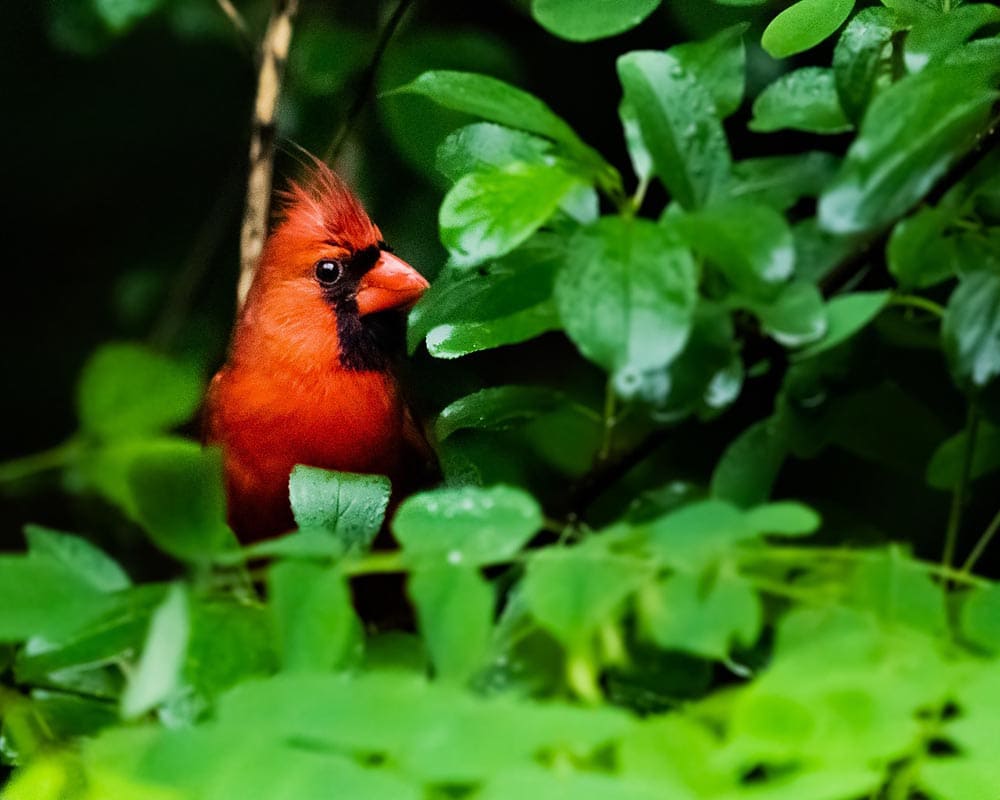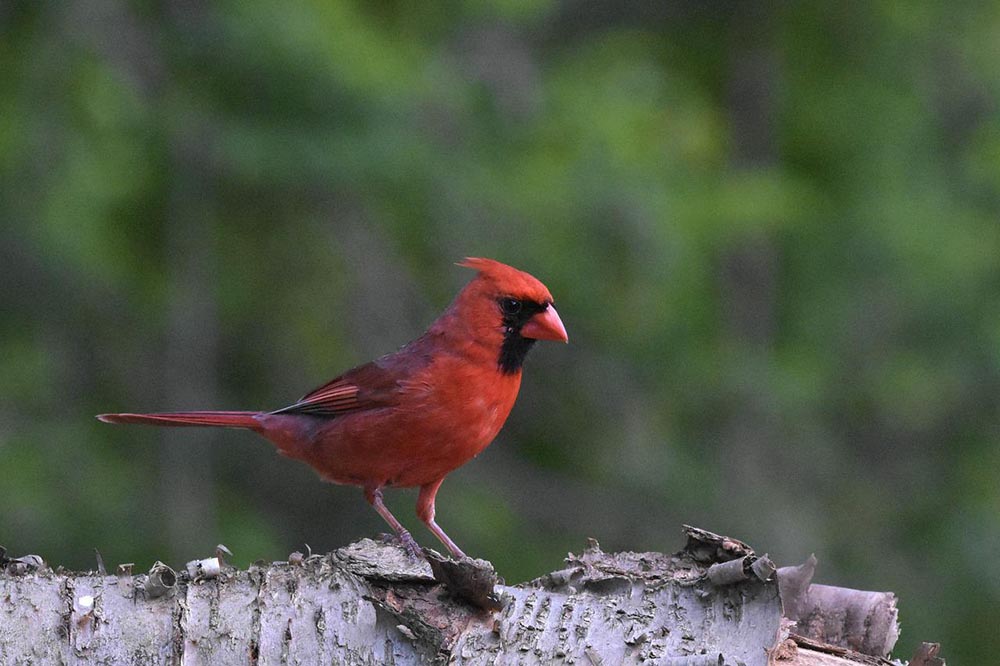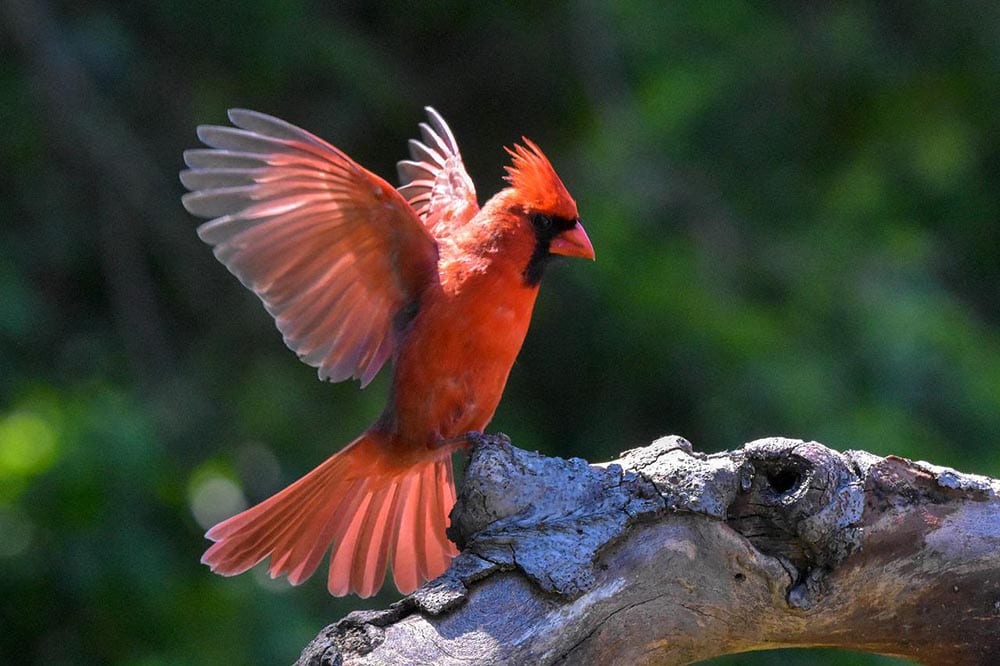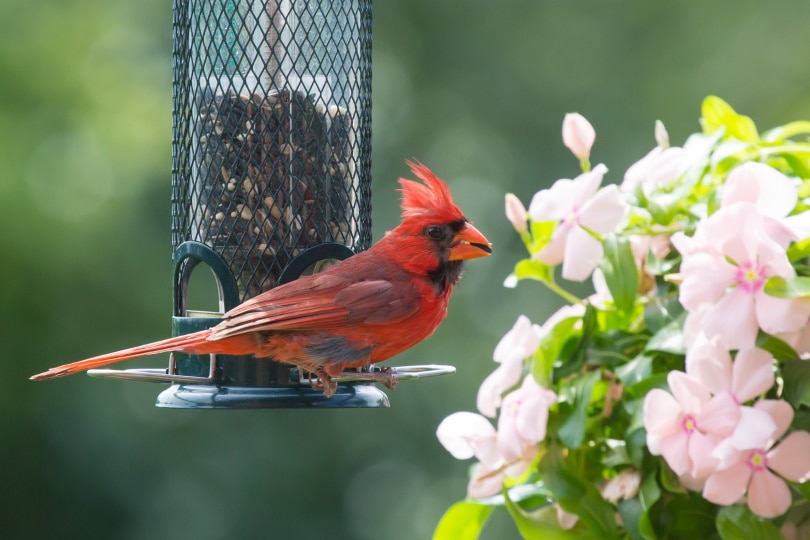What Do Cardinals Eat? What You Need To Know!
Last Updated on

If you’ve been wondering how you can lure Cardinals to your backyard, today’s your lucky day.
Well, the answer is simple: find out what their dietary needs are and make the necessary changes. We reckon the one mistake that a lot of people make is assuming that bird food is universal. When in reality, it’s not. We have birds that are herbivorous, omnivorous, granivorous, carnivorous, and even insectivorous.
Our friends the Cardinals happen to like fruits, seeds, grains, and sometimes insects. That means, unlike most bird species, they’re not picky eaters. We’ve also spotted their younglings feed on greens and alfalfa sprouts if they are accessible.
Read on below to find out more!

What Type Of Bird Is The Cardinal?
Cardinals belong to the order Passeriformes, otherwise referred to as the perching birds. In total, there are 53 different subspecies recognized by the International Committee of Ornithologists (IOC). Sadly though, only two of those exist in the United States. That is the Northern Cardinal and the Red-Crested Cardinal.
But when you hear someone talk about a Cardinal, they are most likely talking about the Northern Cardinal. It’s the most common redbird in that spectrum, as it has inhabited our rural areas, the woodlands, and suburbs. What’s more, we’ve just recently learned that they are also common in Mexico and the southern parts of Canada.
Distinguishing the males from the females is fairly easy. Males tend to look like they’re wearing a black mask, while females often sport reddish streaks on their wings, crests, and tails. On average they only weigh 1.5 to 1.7 ounces and measure 8.1 to 9.3 inches long.
Naming
Most of you might not know that religion played a big role in naming this species. You see, the European settlers couldn’t help but compare that red plumage to the vestments typically worn by their religious leaders, the Catholic Cardinals. The species’ crest also resembles the headgear only reserved for their higher officials.
Cardinal is a derivative of the Latin word “Cardo,” which translates to “hinge.” As per the laws of Catholicism, the elections of those who serve within that religion have to “hinge” upon the Cardinals. So clearly, this bird was revered in that community.
Common Call
The other thing that makes this particular songbird so special is the fact that both the males and females are able to sing. We’ve studied songbirds for quite a long time now, so we can say with conviction that singing is a male thing.
Cardinals have around 28 distinct song phrases, and like singing while perched on the highest tree branches. The male will sing anytime he’s trying to attract a mate, and the female will sing to let her spouse know that she’s hungry.

What Do Cardinals Eat?
Baby Diet
The clutch size of a Cardinal is three to four eggs. And they usually lay eggs twice a year, during spring and summer. Once the eggs have hatched, the female will stay with her chicks to offer warmth and protection, while the male goes out to search for food. To ensure the younglings grow up to be strong enough to survive in the wild, they’ll only be fed protein and fat-rich insects.
The frequency at which they are fed varies as it depends on the time of the year and the availability of food. If the food stores are running dry they’ll only be fed three to four times per hour. But if the food is in abundance, that number can go up to eight times per hour.
This will go on for close to a week before they revert to two to four meals every hour. From what we’ve learned, the fledglings should be strong enough to leave the nest after 2 months.
Adult Diet
As the Cardinals grow older, their diets change. But that doesn’t mean that they stop eating the insects they were being served by their parents. They just branch out to include other things. It’s important to them to try out new things to ensure they never go hungry should they run out of insects to prey on. Diversifying their diet is also meant to guarantee their bodies get all the essential nutrients it requires to function efficiently.

Fruits
It’s honestly not easy to find a Cardinal starving given most of them have settled near swamps, farmlands, suburbia, and small towns. All these are places where they can quickly forage for the fruits they want to eat as the supply is never short.
If they are in the mood to have fruits, they’ll go for serviceberries, crabapples, elderberries, or mulberries. And because they are not as picky as other species, they’ll even settle for the fruit from the poison ivy plant.
What if you can’t find these fruits in the store near you? Well, you could always share what you have in your refrigerator. Do you have grapes? Raisins? Or apples? Go ahead and share whatever you have, even if it’s in a dry state.
Seeds
From our observations, it seems like black oil sunflower seeds are the favorite in this category. They always go for them because those seeds are easy pickings, besides the fact that they are full of the essential micronutrients such as calcium, fiber, protein, vitamin B, fat, vitamin E, and iron. Their oil content is also relatively high, compared to striped or hulled sunflower seeds.
Their second favorite seeds are the ones produced by the safflower plant. And these are readily available in most stores. Sparrows and squirrels hate these types of seeds, so they are the perfect substitute if you’ve been struggling to keep them at bay.
Nonetheless, they’ll eat any seed as long as it’s edible and digestible. If the seed has one of those hard coats, they’ll break it using their bills and eat the kernel whole.
Insects
The good thing about housing Cardinals is that they’ll always help you deal with the pesky insects that make your life miserable. They’ll eat all those slugs, grasshoppers, spiders, crickets, cicadas, and even flies.

How to Invite Cardinals to Your Backyard
First off, you have to be certain that these birds are native to your area before trying to attract them. And once you are, think about the things they like, and how to offer them a quality life. Their preferred habitat is one that gives them easy access to food, water, and shelter.
In the eyes of the Cardinal, your pet will be a predator—even if it’s a cat that’s not feral. So remember to lock your pets indoors, and only take them outside if you have to. Cardinals are early risers, so you can let them play outside in the afternoon.
All reflective surfaces should be removed, as Cardinals tend to fight with their own reflections. They often think that their images are other birds trying to invade their territory.

Bird feeders
Although they’re territorial in nature, you’ll rarely find them fighting over food with other species. They usually visit feeders very early in the morning and go back very late in the evening. That means by the time other birds get there they’ll have already left.
But the type of feeder that you end up installing should have a larger platform. If it’s not big enough, your Cardinals will have a hard time landing.
The height of the feeder is the other factor that they’ll take into consideration. It has to be closer to the shrubs or tree branches, and more than 6 feet above the ground. That way, they’ll always feel protected while feeding.
Birdbaths
Cardinals understand the purpose of a birdbath is to ensure they clean themselves well and stay hydrated. However, they won’t go anywhere near anything that’s more than 3 inches deep. They are intelligent enough to know that’s a deathtrap, given their size. Mind you, these birds were not born with features that typically define an aquatic bird. They’ll drown the minute they go in.
During winter, you’ll have to find a way to install a heater that will warm up the water.
Landscaping
You honestly don’t have to have a green thumb to lure Cardinals to your yard. Anyone can do it, as long as they are committed. Anyways, to enhance your landscape, you’ll have to add a few plants, flowers, shrubs, and trees.
The best plants are blueberries, mulberries, and sumac. Flowers, as we’ve already established, should be sunflowers, poppies, asters, and anything else that produces tasty seeds. The shrubs are meant to entice the female to build a nest there. So we’ll go with the viburnum species, gray dogwood, or clematis. The trees can be anything as long as it provides sufficient cover that can function as a hideout.

Frequently Asked Questions
Is cleaning my birdfeeder necessary?
Absolutely. Let’s not assume that birds can survive anything just because they’ve been raised in the wild. Decomposing or moldy seeds can quickly compromise their avian immune system and ultimately kill them.
If you care about your birds, you’ll clean your feeder at least once every month. And it should be a thorough exercise that includes disinfecting and rinsing the surfaces. Disinfect using bleach and then rinse using clean water.
Are we supposed to offer seeds all year-round?
You’re going to have to make sure that the feeder has adequate food every time the bird visits. The thing is, the Cardinals are not migrators. Even if the weather changes or their food supply is running low, they’ll survive on what’s available. So if you’d wish them to build a permanent home in your backyard you should fill those feeders every so often.

Conclusion
Cardinals are not fussy eaters and feed happily on a variety of seeds, fruits, and even insects. If you take good care of your Cardinals, they’ll easily clock 15 years. In the wild, they only live up to 3 years. But that’s because they have to deal with so many things, including predatory attacks and starvation. Place those feeders at the right spot and they’ll deliver endless hours of entertainment.
Featured Image Credit: GregSabin, Pixabay
About the Author Robert Sparks
Robert’s obsession with all things optical started early in life, when his optician father would bring home prototypes for Robert to play with. Nowadays, Robert is dedicated to helping others find the right optics for their needs. His hobbies include astronomy, astrophysics, and model building. Originally from Newark, NJ, he resides in Santa Fe, New Mexico, where the nighttime skies are filled with glittering stars.
Related Articles:
What Is the Best Binocular Magnification for Hunting? Optical Features Explained
Can You Use Binoculars to Look At Stars? How to Choose the Right Pair
10 Types of Hummingbirds in Arkansas (With Pictures)
8 Types of Hummingbirds in Nebraska (With Pictures)
5 Types of Hummingbirds in Idaho (With Pictures)
3 Types of Hummingbirds in Mississippi (With Pictures)
8 Types of Hummingbirds in Kansas (With Pictures)
5 Types of Hummingbirds in West Virginia (With Pictures)
